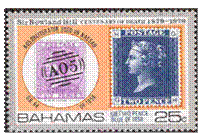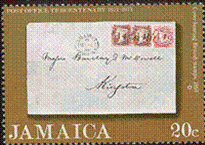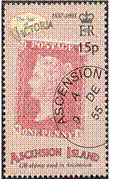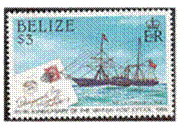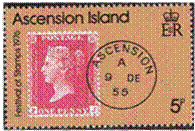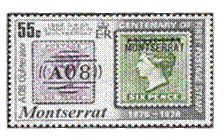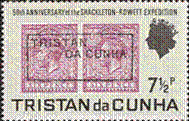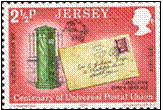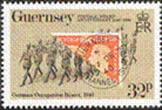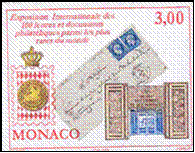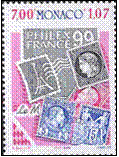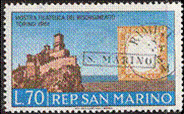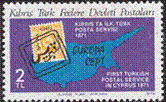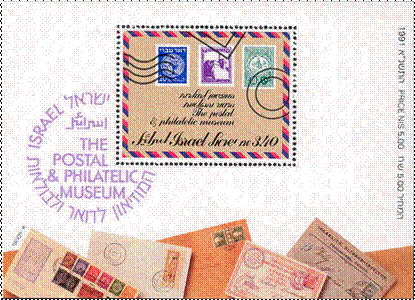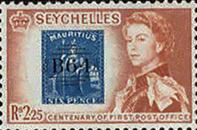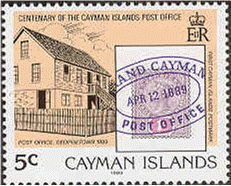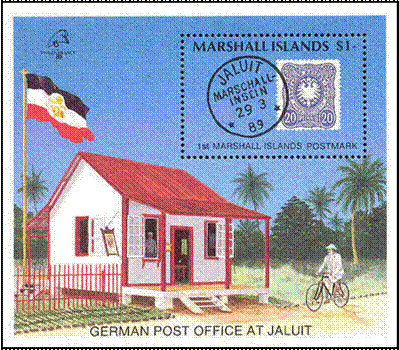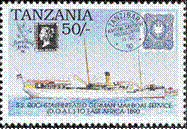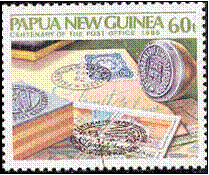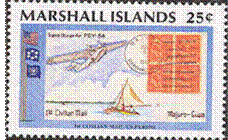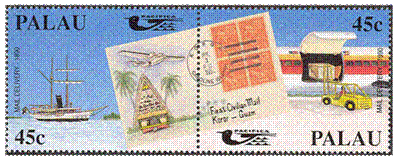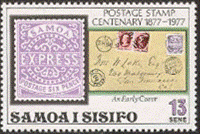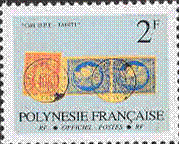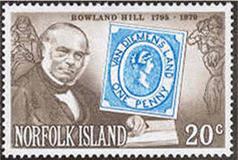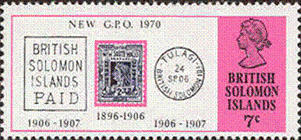|
STAMPS ON STAMPS COLLECTORS CLUB |
|
The Stamp
Whispers, the Letter Speaks, By Martin Hirschbühl |
|
Please allow me to
introduce you to a special and precious type of SOS I have always loved most:
I call them “chameleon stamps”. No, it has nothing to do with holograms or
other nowadays stuff! They don’t change their color, but only their status or
homeland. Like in fairytales, sometimes a simple German or British stamp
turns out to be a colonial rarity having both philatelic and historical (or commercial) value. Going through my SOS
collection, only a few such gems can be found. The largest group is
reproductions of British stamps with numerical postmarks, enabling us to
classify them as being used in the Bahamas (A05), Belize (A06), Montserrat
(A08), St. Vincent (A10) or Jamaica (A49). And, of course, don’t forget the
Guyana stamps of 1980 (not shown at right).
The use of British stamps in Ascension,
featured on two similar SOS, seem to be very different with a
circle-date-postmark instead of a numerical-killer. The latest British stamps
“used abroad” to be found on a SOS is a pair of George VI 6d with a Tristan
da Cunha provisional Bar cancellation of the early 1920’s, during Sir Ernest
Shackleton’s explorations.
The British
mainland is represented here with Jersey’s UPU 1974, showing a classical
cover of 1852, mailed in Jersey around a centenary before the author’s birthday.
It was recently discovered that the color of Jersey’s first letterbox was
red, not green as shown on the stamp, another amusing “Error-SOS”...! Guernsey
features an occupation bisect of the British two pence centenary stamp, used
as a provisional penny postage, probably influenced by so-called “philatelic
needs”. Both these
items are now landmarks in the postal history of the Channel Islands.
Prior to
the issuance of their own stamps, many countries around the world were using
foreign or mainland stamps. Early Imperial Austrian stamps with postmarks of
“Pesth” (now Budapest) or “Pressburg” (now Bratislava) on a recent Slovakian
SOS are just two examples of a period long ago. It reminds me of the Latin
sentence “Sic transit Gloria mundi” (Bogey fans translate it “as time goes
by”).
The
principality of Monaco first used Sardinian stamps up to 1859. After Napoleon
III sacked the Côte d’ Azur as a waraid-bonus, they were replaced by
French stamps, remaining in circulation for at least 25 years, maybe longer,
after the issue of their own stamps in 1885. It seems
that French-Monaco joint frankings still have been possible as reproduced on
Monaco’s Philexfrance ‘99 SOS.
San Marino,
the world’s oldest existing republic, presents a Sardinian 5c stamp with both
circle and bar-stamp of Rimini and S. Marino. On the SOS they kindly embossed
the head of Vittorio Emanuele, like on the original stamp. Grazie tanto!
“San Marino, the world’s oldest ,….” My journey
through Europe ends with an Imperial Osmanian stamp, used in 1871 in the
later Turkish part of Cyprus. This Greek-Turkish conflict has been boiling
for a long time.
Another
“hot spot” of the ancient Osmanian Empire was Palestine (now Israel). The SOS
sheetlet features not only Turkish, Palestine and Israel stamps or labels, but
also an Imperial Austrian postcard surcharged for use in Turkey, with a
“Jerusalem” postmark. What a brilliant item for every Judaica collector (and
for SOS guys too, or course)!
Going back
to the colonies, a nice B64 postmark on Mauritius 6d is shown here on
Seychelles, and the first Cayman Islands oval dated handstamp on a Jamaican
stamp, both appearing on a SOS one century later.
The German
colonies only existed for a short period, but long enough to leave some
philatelic tracks. The same old common 20 Pfennig Blue Eagle of the former
Reichspost is now reproduced on Marshall Islands, Papua New Guinea and
Tanzania, with different postmarks of each region.
Of unique
interest is Palau’s se-tenant block. First they were using German stamps,
later Marshall-Insel overprints, finally Karolinen definitive stamps. This is
a real appetizer, inviting us to dive deeper into this colorful postal
history.
A wartime
naval letter of 1943 is depicted on a Tuvalu SOS, and two similar “First
Civilian Mail” letters from the Marshall Islands and Palau. Both of them
proved that one could once send a letter halfway around the world for just 2
cents postage. Unbelievable!!
A classical
Samoa letter of 1881 from Apia to San Francisco with additional US postage
documents the foreign use of US stamps. Issued for the Samoan stamp centenary
in 1977.
The wide
range of French stamps used in their colonies is represented with only one
service stamp of Polynesia (French stamps with Papeete postmark).
Finally,
here are two examples that don’t quite qualify to be real chameleons. Did you
know that Norfolk Island was a former part of Van Diemens Land, or that the
Solomon Islands once had New South Wales stamps in use? I really wish they
wouldn’t forget to print the postmarks, too, on their SOS. At the end
of the day, I wish for me and the benefit of all my SOS collecting colleagues
that more countries would issue additional appealing stamps-on-stamps
incorporating postal history into their designs. I hope you agree…..?
|
||||||||||||
